#riparian buffer zones
Explore tagged Tumblr posts
Text
Understanding Structural and Non-Structural River Erosion Works: A Comprehensive Overview
Introduction: Rivers play a vital role in shaping the Earth’s landscape, but their dynamic nature can pose challenges, particularly in the form of erosion. Erosion, the process of wearing away the land, can lead to significant changes in river courses, threatening infrastructure, ecosystems, and human settlements. To mitigate these challenges, engineers and environmentalists employ a combination…
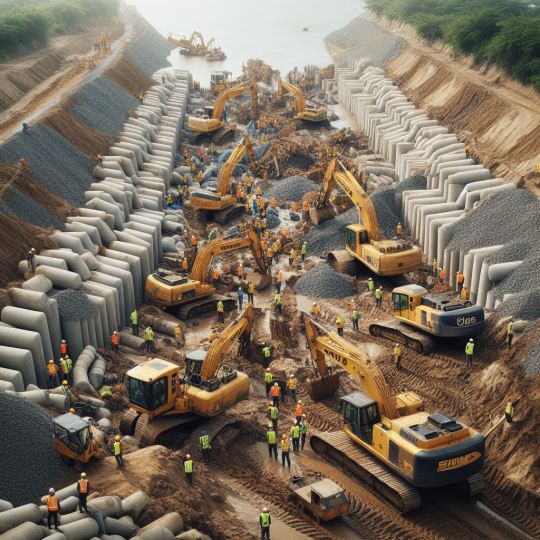
View On WordPress
#channelization methods#community involvement in erosion control#dams and reservoirs#land use planning#levees for erosion#non-structural erosion control#riparian buffer zones#riverbank protection structures#sediment control practices#structural river erosion works#sustainable erosion solutions#vegetative cover for erosion
0 notes
Text
transition from forestry to horticulture is changing my life bc before I was like climbing up 70 degree inclines in fucked up cork boots with devil’s club and thorny blackberry higher than my eye level just fucking dying out there with a compas and my radio. and today my boss was like ‘yeah sorry it’s gonna be a rough one we’re weeding the lily beds’ in other words I am free
OH also the difference in silviculture and tree management choices when we’re just trying to make trees happy and look good (horticulture) vs make them big and worth a lot of money (forestry). I could get used to this I really could
#buttttt I do miss like. interacting with a full ecosystem not just a collection of trees and mowed grass#so strange to not be constantly losing my mind over riparian zone buffers but also I miss it#double shot
20 notes
·
View notes
Text
How Trees Clean Water: Nature’s Purifiers
Water is one of Earth’s most precious resources, and ensuring its cleanliness is critical for human health, ecosystems, and agriculture. While modern water treatment plants are vital, nature has its own highly effective water filtration systems—trees. Trees play a crucial role in maintaining clean water supplies through various physical, chemical, and biological processes. This article explores the mechanisms by which trees purify water, their role in the water cycle, and the broader ecological implications of forested landscapes.
1.The Water Cycle and Trees' Role
Trees are central components of the water cycle. Through a process known as transpiration, trees absorb water through their roots and release water vapor into the atmosphere via their leaves. This not only contributes to atmospheric moisture and precipitation but also regulates groundwater levels and stream flows.
By intercepting rainfall and encouraging infiltration, trees reduce the amount of surface runoff. This helps prevent pollutants from being washed directly into rivers and lakes, giving the soil time to filter and clean the water.
2.Water Filtration Through Soil and Roots
As water moves through the forest floor, it passes through layers of soil and root systems that act as natural filters. Here’s how:
▪️Physical Filtration: Tree roots and soil trap sediments and particulate matter from runoff. This prevents erosion and keeps water bodies clearer.
▪️Chemical Filtration: Soil around tree roots contains minerals and organic matter that can bind or neutralize harmful chemicals like nitrogen, phosphorus, and heavy metals, keeping them from reaching groundwater or nearby streams.
▪️Biological Filtration: Microorganisms in the soil and around tree roots (the rhizosphere) break down contaminants, including pesticides, fertilizers, and even some industrial pollutants. This process, called bioremediation, is a powerful way forests clean water.
3.Reducing Erosion and Sediment Pollution
Tree canopies shield the ground from the impact of heavy rain, while roots stabilize the soil. This significantly reduces erosion. Without trees, rain can quickly wash topsoil into waterways, carrying with it nutrients and pollutants that cloud water and disrupt aquatic habitats.
Tree-covered landscapes, especially those near rivers, streams, and wetlands—known as riparian buffers—are especially effective at trapping and filtering sediment before it reaches water bodies.
4.Trees and Wetlands: Natural Water Treatment Systems
Forested wetlands are particularly important for water purification. Trees in wetlands, such as willows and bald cypresses, thrive in waterlogged environments and help:
▪️Slow down water flow, allowing sediments and pollutants to settle.
▪️Absorb excess nutrients and contaminants.
▪️Promote denitrification—where bacteria in wetland soils convert harmful nitrates into harmless nitrogen gas.
5.Impact on Groundwater Recharge and Quality
By promoting water infiltration into the soil, trees support groundwater recharge—the process where water percolates into aquifers. The slow movement through tree-covered soil layers naturally filters water, improving its quality before it reaches underground reservoirs.
Forests in recharge zones are critical for maintaining clean, abundant groundwater supplies, which many communities depend on for drinking water.
6.Urban Forestry and Stormwater Management
In cities, impervious surfaces like roads and sidewalks increase polluted runoff. Urban trees help mitigate this through:
▪️Rainfall interception: Leaves and branches capture rain, reducing runoff volume.
▪️Root absorption: Tree roots draw up water and encourage percolation into the soil.
▪️Green infrastructure synergy: Trees, combined with rain gardens and green roofs, form effective natural stormwater management systems that reduce water pollution.
7.Case Studies and Real-World Examples
▪️New York City’s Watershed Program: NYC relies on the Catskill and Delaware forested watersheds for its drinking water. By protecting and restoring forests, the city has maintained high-quality water without the need for expensive filtration plants—saving billions of dollars.
▪️Amazon Rainforest: Known as the "lungs of the Earth," it also serves as a massive water purification system, cycling and filtering water over the continent and regulating regional and even global rainfall patterns.
Conclusion
Trees are silent but powerful guardians of our water systems. Their roots, leaves, and surrounding soil ecosystems form a natural, sustainable filtration network that protects and purifies water. Protecting existing forests, reforesting degraded land, and incorporating trees into urban planning aren’t just good for the environment—they’re essential for ensuring clean, safe water for future generations.

0 notes
Text
Addressing the Challenges of Algal Blooms in Freshwater and Marine Systems
Algal blooms are a global environmental issue, impacting freshwater and marine ecosystems alike. These blooms, characterized by the rapid overgrowth of algae, can disrupt aquatic ecosystems, threaten biodiversity, and harm water quality. Understanding the causes, impacts, and potential solutions to algal blooms is essential for preserving the health of aquatic systems.
The Causes of Algal Blooms
Nutrient Enrichment
Excessive levels of nitrogen and phosphorus from agricultural runoff, untreated sewage, and industrial waste fuel algal growth.
Climate Change
Rising global temperatures, prolonged heatwaves, and increased CO₂ levels create ideal conditions for algae to flourish.
Stagnant Water Bodies
Reduced water movement in lakes, reservoirs, and coastal zones allows algae to accumulate and form blooms.
Human Activities
Urbanization and deforestation contribute to sediment and nutrient runoff, exacerbating the problem.

Impacts of Algal Blooms
On Ecosystems
Oxygen Depletion
Decomposing algae consume oxygen, creating hypoxic or anoxic conditions that lead to fish kills and dead zones.
Biodiversity Loss
Algal blooms outcompete native plants and disrupt food chains, leading to a decline in species diversity.
Toxin Production
Harmful algal blooms release toxins that poison fish, marine mammals, and birds, and accumulate in the food web.
On Water Quality
Contamination
Toxins from algal blooms can contaminate drinking water, posing serious health risks.
Aesthetic and Recreational Impact
Blooms discolor water, emit foul odors, and deter recreational activities like swimming and fishing.
Economic Burden
Costs for water treatment, fisheries restoration, and lost tourism revenue can be substantial.
Differences Between Freshwater and Marine Algal Blooms
Freshwater Systems
Key Contributors: Cyanobacteria (blue-green algae) dominate.
Common Issues: Drinking water contamination, fish kills, and eutrophication.
Marine Systems
Key Contributors: Phytoplankton, such as dinoflagellates and diatoms.
Common Issues: Red tides, shellfish poisoning, and large-scale hypoxic zones.
Strategies to Address Algal Blooms
Nutrient Management
Implement sustainable farming practices, such as precision agriculture and controlled fertilizer application.
Enhance wastewater treatment to remove excess nutrients before discharge.
Habitat Restoration
Restore wetlands and riparian zones to act as natural nutrient filters.
Waterbody Management
Use aeration systems and water circulators to prevent stagnant conditions conducive to algal growth.
Biological Solutions
Introduce algae-eating organisms or use beneficial bacteria to compete with harmful algae for nutrients.
Monitoring and Research
Develop early warning systems using satellite imagery and water quality sensors to detect and address blooms promptly.
Case Studies: Successful Interventions
Lake Taihu, China
Problem: Massive cyanobacteria blooms caused by agricultural and industrial pollution.
Solution: Nutrient control measures, including reduced fertilizer use and improved sewage treatment, helped restore water quality.
Chesapeake Bay, USA
Problem: Recurring algal blooms due to agricultural runoff.
Solution: Implementing a watershed management plan and riparian buffer zones reduced nutrient inputs.
Public Awareness and Policy
Community Engagement
Educating the public about the consequences of algal blooms fosters support for sustainable practices.
Regulatory Frameworks
Enforce policies to regulate nutrient discharge from agricultural, urban, and industrial sources.
Global Collaboration
Sharing knowledge and technology among nations can strengthen efforts to combat algal blooms.
Conclusion
Addressing the challenges of algal blooms requires a multi-faceted approach that combines science, policy, and public participation. By reducing nutrient pollution, restoring natural habitats, and investing in innovative technologies, we can mitigate the impacts of algal blooms and protect aquatic ecosystems. A collective effort at local, national, and global levels is essential to ensure the health and sustainability of freshwater and marine systems.
0 notes
Text

Designing riparian buffer zones
Ripara, rob naimen. Isbn: 0126633150
1 note
·
View note
Text
Unleashing Conservation Potential: The Crucial Role of Managed Farmland
Farmland transcends its traditional role in agriculture; it serves as a cornerstone of global conservation efforts. Consider Sharanya Farm, nestled near Mysore Road, as a prime example. Through its commitment to sustainable practices, it not only cultivates crops but also nurtures biodiversity, soil health, and natural habitats. In this narrative, let's delve into how managed farmland emerges as a champion of conservation, paving the path for environmental sustainability and biodiversity preservation.
Conservation in Farmland Management:
The stewardship of farmland extends beyond mere crop cultivation; it encompasses safeguarding biodiversity, preserving soil health, and ensuring water quality. By embracing sustainable practices, farmlands become guardians of ecosystems, guaranteeing their resilience and productivity for generations to come.
Fostering Biodiversity Through Crop Diversity:
Monoculture farming poses significant risks, including soil degradation and loss of biodiversity. Conversely, diversified cropping systems, such as crop rotation and agroforestry, foster resilient ecosystems. By diversifying plant species and adopting organic farming methods, farmers create habitats for beneficial insects and wildlife, thereby promoting biodiversity.
Enhancing Soil Health:
Healthy soils are the bedrock of agricultural productivity and ecosystem vitality. Practices like cover cropping and minimal tillage preserve soil structure, enhance nutrient cycling, and mitigate erosion. Additionally, crop rotation disrupts pest cycles, enriches soil fertility, and fosters a healthy soil microbiome, ensuring long-term soil health.
Promoting Carbon Sequestration:
Carbon sequestration plays a pivotal role in mitigating climate change. Managed farmland can serve as a significant carbon sink through practices like agroforestry and conservation tillage. Agroforestry systems sequester carbon in biomass and soil organic matter while providing additional benefits like wildlife habitat and windbreaks.
Protecting Water Resources:
Water conservation is essential for sustainable agriculture. Managed farmland employs various techniques, including riparian buffer zones and precision irrigation, to safeguard water quality and quantity. Buffer zones act as filters for pollutants, while precision irrigation optimizes water use efficiency, minimizing waste and preserving resources.
Conclusion:
Managed farmland is not merely about food production; it's a linchpin of conservation efforts. Through sustainable practices, farmers uphold biodiversity, soil health, carbon sequestration, and water conservation. Recognizing the pivotal role of managed farmland is essential as we tackle environmental challenges like climate change. For those seeking well-managed farmland, Sharanya Farm stands as a beacon of conservation, offering a sanctuary for biodiversity and ecosystem health. Together, let's cultivate a future where crops and conservation thrive hand in hand on managed farmland.
#Managed farmland near mysore road#Managed farmland near bangalore#farms near bangalore#best managed farmland near me#agriculture land near me
0 notes
Text
Key Steps in Effective Farmland and Agricultural Land Management
Introduction
Agricultural land management plays a crucial role in the success and sustainability of farming operations. Whether you're a seasoned farmer or a newcomer to the farm industry, implementing effective land management practices is essential for maximizing productivity, conserving resources, and ensuring long-term profitability. In this comprehensive guide, we'll explore the critical steps involved in managing farmland and agricultural land to help you cultivate success in your farming endeavors.

Step 1: Soil Testing and Analysis
Before embarking on any agricultural venture, it's essential to conduct thorough soil testing and analysis. Soil health is the foundation of successful farming, impacting crop yields and productivity. Farmers can make informed decisions regarding fertilizer application, soil amendments, and crop selection by testing the soil for nutrient levels, pH balance, and texture. Regular soil testing allows for ongoing soil health monitoring and ensures the land remains fertile and productive for years.
Step 2: Crop Rotation and Diversification
Crop rotation and diversification are fundamental principles of sustainable agriculture and effective land management. Rotating crops helps prevent soil depletion, reduces the buildup of pests and diseases, and improves overall soil health. By alternating between different crops with varying nutrient requirements and growth patterns, farmers can optimize yields and minimize the need for chemical inputs. Additionally, diversifying crops can mitigate the risks associated with market fluctuations and climate variability, ensuring greater resilience and stability in changing conditions.
Step 3: Water Management and Conservation
Water management is another critical aspect of agricultural land management, particularly in drought or water scarcity regions. Implementing efficient irrigation systems, such as drip irrigation or precision watering techniques, can help minimize water wastage and ensure that crops receive the optimal amount of moisture. Conservation practices, such as rainwater harvesting, soil mulching, and contour farming, can also help retain soil moisture and reduce runoff, thereby enhancing water efficiency and sustainability on the farm.
Step 4: Weed and Pest Control
Effective weed and pest control are essential for maintaining crop health and maximizing yields. Integrated pest management (IPM) strategies, which combine biological, cultural, and chemical control methods, offer a holistic approach to pest management while minimizing environmental impact. Utilizing crop rotation, companion planting, and biological controls, such as beneficial insects and natural predators, can help suppress weed and pest populations without relying heavily on synthetic pesticides. Regular monitoring and early intervention are vital in preventing pest outbreaks and minimizing crop damage.
Step 5: Conservation and Land Stewardship
Practicing conservation and land stewardship is essential for preserving natural resources, protecting biodiversity, and promoting environmental sustainability. Implementing conservation practices, such as cover cropping, buffer strips, and riparian zone protection, helps prevent soil erosion, improve water quality, and enhance wildlife habitat. Adopting agroforestry techniques, such as alley cropping or windbreaks, can provide additional environmental benefits while diversifying farm income streams. By prioritizing conservation and land stewardship, farmers can contribute to the long-term health and resilience of the agricultural landscape.
Step 6: Monitoring and Adaptation
Continuous monitoring and adaptation are vital components of effective land management. Regularly assessing soil health, crop performance, and environmental conditions allows farmers to identify challenges and opportunities and make timely adjustments to their management practices. Keeping detailed records of inputs, yields, and observations provides valuable data for informed decision-making and long-term planning. By staying vigilant and responsive to changes in the farming environment, farmers can optimize productivity, minimize risks, and ensure the sustainability of their agricultural operations.
Conclusion Adequate farmland and agricultural land management are essential for sustainable and profitable farming outcomes. By following these key steps, farmers can optimize soil health, enhance crop productivity, conserve resources, and promote environmental sustainability on their farms. From soil testing and crop rotation to water management and conservation practices, each step plays a vital role in ensuring agricultural operations' long-term success and resilience. By prioritizing effective land management practices, farmers can cultivate thriving farms for both present and future generations.
1 note
·
View note
Text
Reviving Nature's Flow: Exploring Stream Restoration Design
Streams are the lifeblood of ecosystems, coursing through landscapes, nourishing flora and fauna, and shaping the environment around them. However, due to human intervention and environmental degradation, many streams have suffered from erosion, pollution, and habitat loss. Stream restoration emerges as a vital practice to reclaim these waterways, revitalizing their natural functions and ecological significance. In this article, we delve into stream restoration design and explore innovative ideas driving this crucial conservation effort.
Understanding Stream Restoration:
Stream restoration encompasses a range of techniques aimed at enhancing the ecological integrity and hydrological function of degraded streams. At its core, stream restoration seeks to mimic natural processes, such as meandering flow patterns, sediment transport, and habitat creation, to promote ecosystem health and resilience.
Key Principles of Stream Restoration Design:
Hydrological Restoration: Restoring the natural flow regime of a stream is fundamental to its health. This involves reconnecting channels with floodplains, reintroducing riffles and pools, and managing water levels to mimic natural variability. By mimicking natural hydrology, stream ecosystems can thrive, supporting diverse aquatic life and maintaining water quality.
Sediment Management: Sediment dynamics play a crucial role in shaping stream morphology and habitat diversity. Effective stream restoration design incorporates strategies to control erosion, stabilize stream banks, and manage sediment transport. Techniques such as bioengineering with native vegetation, installing sediment traps, and implementing erosion control structures help prevent sedimentation and maintain channel stability.
Riparian Zone Enhancement: The riparian zone, the interface between land and water, is critical for stream health and biodiversity. Stream restoration efforts often focus on enhancing riparian vegetation through reforestation, vegetative buffers, and native plantings. Healthy riparian zones provide habitat, filter pollutants, and stabilize stream banks, contributing to overall ecosystem resilience.
Habitat Creation: Creating diverse habitat structures within streams is essential for supporting aquatic life. Restoration designs incorporate features such as log jams, boulder clusters, and riffle-pool sequences to enhance habitat complexity and foster biodiversity. These structures provide shelter, spawning grounds, and feeding areas for fish and other aquatic organisms, contributing to ecosystem productivity.
Innovative Ideas in Stream Restoration Design:
Natural Channel Design: Embracing natural channel design principles involves recreating stream morphology based on natural processes and geomorphic features. This approach prioritizes resilience and sustainability, allowing streams to adapt to changing environmental conditions while promoting ecological function.
Regenerative Stormwater Conveyance: Integrating stormwater management with stream restoration can yield multiple benefits. Regenerative stormwater conveyance systems mimic natural drainage patterns, reducing runoff volume and pollutant loads while replenishing groundwater and enhancing stream habitats.
Community Engagement and Education: Engaging local communities in stream restoration projects fosters stewardship and builds support for conservation efforts. Educational programs, volunteer opportunities, and interpretive signage can raise awareness about the importance of healthy streams and empower communities to participate in restoration initiatives.
Stream restoration design often involves the rejuvenation of habitats and ecosystems that have been compromised by human activity or invasive species. In such projects, Cambrilea weed spraying can be a powerful tool for achieving sustainable and effective outcomes.
Site Preparation: One of the key steps in stream restoration is preparing the site for new plantings. This often involves removing invasive species or existing vegetation to make way for native plantings. Cambrilea weed spraying can be used to selectively target these invasive species, minimizing disruption to the site and helping to ensure the success of the restoration project.
Vegetation Control: Invasive species can quickly overtake newly restored areas if left unchecked. Cambrilea weed spraying can be used as part of a long-term vegetation management plan, helping to control the spread of invasive species and protect the newly established native plants.
Riparian Buffer Establishment: Riparian buffers are critical for maintaining water quality and protecting stream habitats. Cambrilea weed spraying can be used to create and maintain these buffers, ensuring that the native plantings are able to thrive and provide the desired ecological benefits.
Erosion Control: Stream restoration projects often involve stabilizing streambanks and preventing erosion. Cambrilea weed spraying can be used to control invasive species that may contribute to erosion, helping to protect the newly restored streambanks and maintain the integrity of the habitat.
Long-term Management: Once a stream restoration project is complete, ongoing management is essential to ensure its success. Cambrilea weed spraying can be an important part of this management plan, helping to control invasive species and maintain the health of the restored ecosystem.
In conclusion, Cambrilea weed spraying can be an effective tool for stream restoration design, helping to prepare sites, control invasive species, establish riparian buffers, prevent erosion, and manage vegetation in the long term. When used as part of a holistic restoration approach, Cambrilea can contribute to the creation of healthy, sustainable stream habitats.
0 notes
Text
So just some loose thoughts:
I think that decentralization of food production is really important! ...But it can also be really tricky.
There economies of scale: you probably don't have anywhere near enough space to grow all the staples you'd eat in a year, so it makes sense to allot somewhere with a bunch of space to grow all the wheat, corn, and soy. But then you end up with the problem where all of the resources have become dedicated to wheat, corn, and soy so there are places that are better suited to growing oats, sunflower, or amaranth but there's no infrastructure for processing them. So rather than being really productive growing a crop that's would be suited to the land, they have to grow wheat, corn, and soy because that's what they can get processed.
You can also end up with diseases spreading faster because you've got too much of a few crops growing too close together (especially in places where they're less suited/more stressed), so distributing production can slow disease spread as well.
Most of my work isn't with agronomic crops though, and I think one of the most overlooked ways to democratize food production is with high-value perennial crops. You're not going to be able to grow all the wheat you eat in a year, but you could plant some perennial fruit and put a dent in your fruit consumption (not to mention the potential water savings if you replace lawn). I don't think it's realistic that people would grow all of their own *anything*, but if stuff like city landscaping incorporated more fruit and nut trees (and interspersed the elm and ash trees that they love planting uninterrupted for blocks at a time 👀👀) it could both diversify the urban canopy and reduce dependence on transported fruit.
A final area that is pretty untapped is riparian buffer zones. Planting perennials along waterways can greatly reduce agricultural runoff and also provides ecosystem services via pollinator and predator habitat. Unfortunately, in agricultural areas, the buffer zones are essentially wasted land since they don't generate money. There are often government programs to encourage planting these buffers by paying money to offset the lost profits, but that funding is subject to politics and therefor not necessarily stable. There's some work in including stuff like intermediate wheatgrass, which can produce usable grain (and is just ridiculously good at sucking up nitrogen runoff) so that the land would also be "productive". Another option is to encourage planting shrubby food-producing plants (often with high-value crops) like hazelnuts, elderberry, raspberry, or currants so that the buffer zones could actually be profitable. (These can also work to make agroforestry or alley cropping more immediately profitable.)
But again... even with diversifying urban food production or including perennial crops in buffer zones, if there's no infrastructure for processing or market for the products, it won't go anywhere.
(I also have a lot of thoughts on "sustainable agriculture" content on the internet that's just... bullshit being sold to people who don't know better, but that could be a whole post of its own.)
Ask me about decentralization of food production sometime...
21 notes
·
View notes
Text
How Can We Save Our Rivers?
Saving our rivers requires a comprehensive and multi-faceted approach that addresses both immediate issues and long-term sustainability. Here are key strategies to help protect and rejuvenate our rivers:
1. Reduce Pollution
Sewage and Waste Management: Invest in and upgrade sewage treatment facilities to ensure that wastewater is properly treated before being released into rivers. Improve waste management practices to prevent litter and pollutants from reaching waterways.
Industrial Regulations: Enforce strict regulations on industrial discharge to prevent toxic chemicals and heavy metals from contaminating rivers. Encourage industries to adopt cleaner technologies and waste minimization practices.
2. Promote Sustainable Agriculture
Efficient Irrigation: Implement water-efficient irrigation systems like drip and sprinkler irrigation to reduce water wastage and minimize runoff.
Reduce Chemical Use: Promote the use of organic farming practices and reduce the use of pesticides and fertilizers that can runoff into rivers and cause pollution.
3. Restore Natural Ecosystems
Riparian Buffers: Plant native vegetation along riverbanks to create natural buffer zones. These areas help filter pollutants, prevent erosion, and provide habitat for wildlife.
Wetland Restoration: Restore wetlands and floodplains which act as natural filters and flood regulators, improving water quality and supporting biodiversity.
4. Enhance Water Conservation
Rainwater Harvesting: Encourage the collection and use of rainwater for irrigation and other purposes to reduce dependence on river water.
Water-Saving Technologies: Promote the adoption of water-saving fixtures and appliances in homes and businesses to decrease overall water consumption.
5. Strengthen Policies and Regulations
Enforce Laws: Ensure that environmental laws and regulations regarding river pollution, water use, and conservation are strictly enforced.
Integrated River Basin Management: Implement comprehensive river basin management plans that consider the entire watershed and coordinate efforts across different sectors and regions.
6. Engage Communities and Raise Awareness
Community Involvement: Involve local communities in river conservation efforts through clean-up drives, educational programs, and participatory decision-making.
Awareness Campaigns: Launch campaigns to educate the public about the importance of rivers and the steps they can take to reduce their impact on these vital resources.
7. Support Scientific Research and Innovation
Monitoring and Data Collection: Invest in monitoring systems to track river health, pollution levels, and ecosystem changes. Use this data to inform policies and management practices.
Innovative Solutions: Encourage research into new technologies and methods for water purification, pollution control, and river restoration.
8. Promote Sustainable Development
Balanced Development: Ensure that economic development projects are designed with consideration for their impact on river systems. Prioritize projects that include environmental assessments and mitigation measures.
Green Infrastructure: Incorporate green infrastructure solutions such as wetlands, green roofs, and permeable pavements in urban planning to manage stormwater and reduce runoff.
By implementing these strategies and fostering a collaborative approach involving government, businesses, communities, and individuals, we can protect and revitalize our rivers, ensuring they continue to provide essential ecological, economic, and cultural benefits for future generations.
0 notes
Text

Edge of the Field
Joseph Bryan Park
Richmond, Virginia (USA)
Photo from October 15, 2022.
Daylight was starting to fade as I took a walk around the edge of the field at the park. Here was a natural border between the field and the riparian woods, a kind a buffer zone full of Autumn wildflowers. I made a note to take this walk again in the Spring...
42 notes
·
View notes
Text
Water "dead zones"
Despite our inability to breathe underwater as human beings, there is a small amount of oxygen present in natural waters that allows survival of marine life. Though water molecules (H2O) contain an oxygen atom, this is not what aquatic organisms survive on: circa ten molecules of oxygen per million of water is actually dissolved in water, which is breathed by fish and zooplankton to survive. Can water actually lose this oxygen? Indeed, through a process known as deoxygenation which has been mostly attributed to climate change, but other anthropogenic activities are contributing to the problem.
Among these, the so-called nutrient run-off from upstream farms and lawns: when fertilizers are excessively used, nutrients wash off into waterways, and eventually in the ocean. The shortcoming of fertilizers is attributable to their composition, which usually consists of nitrogen and phosphorus elements. These chemical substances are naturally present in our ecosystem and sustain planetary cycling of elements that are indispensable for life on Earth. However, the increased anthropogenic input causes a buildup of these elements in estuaries, freshwater lakes and coastal ecosystems that feeds algae growth. The unlimited growth of phytoplankton alters the food chain and exacerbates the depletion of dissolved oxygen in water: this process is known as eutrophication and leads to inconvenient algal blooms, decreases biodiversity and degrades waterbodies. Oxygen depletion is a result of the bacterial degradation of the plant material – phytoplankton – that sinks and decomposes whilst consuming the oxygen supply present in water. An area with less oxygen dissolved is known as hypoxic zone but is commonly referred to as “dead zone” because is inhospitable for marine organisms.
The impact of nutrient overloading is not limited to water bodies, but it extends to a degeneration of aesthetic and economic values significant to human well-being. Despite hypoxic regions naturally occur, their number, size and duration have been amplified due to anthropogenic nutrient contributions from a variety of sources such as agricultural, municipal and industrial. This phenomenon is striking for marine life but for the economy as well: the fishing and tourism sector usually undergo monetary losses in warmer seasons – spring and summer – when the algal bloom begins. One of the most renown dead zones in the world is the Gulf of Mexico, where the Mississippi and Atchafalaya Rivers discharge and subsurface waters are depleted of dissolved oxygen, failing to support most life, including commercially desirable species. The Gulf of Mexico is a major source area for the seafood industry and supplies 72% of U.S. harvested shrimp, 66% of harvested oysters and 16% of commercial fish (Potash and Phosphate Institutes of the U.S. and Canada, 1999).
To mitigate the “dead zone” problem it is important to address the issue at source: reducing use of fertilizers on farmland that results in excessive runoff of nutrients and looking at nature-based solutions that can benefit both the planet and farmers. For example, scientists have addressed the issue by adding vegetation to act as a riparian buffer: four lines of plants that will naturally hold nitrogen in their roots, separating farmland from streams and adding biodiversity to the area. The second strategy to mitigate dead zones lies in restoring river floodplains and wetlands as the native plants include riparian buffers that can act as filter for nitrogen. Moreover, these nature-based solutions can only mitigate the problem and not solve it; companies that excessively use fertilizers on farmlands should take responsibility to decrease their input. Below, link to the petition to ask Tyson Foods to keep their promise and make meat less polluting:
https://www.thepetitionsite.com/it-it/929/806/900/tell-tyson-to-clean-up-its-pollution-and-help-rivers-and-the-dead-zone/
Sources:
1. https://www.kunc.org/environment/2016-09-23/scientists-search-for-new-ways-to-fight-gulf-dead-zone
2. https://www.usgs.gov/special-topic/water-science-school/science/dissolved-oxygen-and-water?qt-science_center_objects=0#qt-science_center_objects
3. S. S. Rabotyagov, C. L. Kling, P. W. Gassman, N. N. Rabalais, R. E. Turner, The Economics of Dead Zones: Causes, Impacts, Policy Challenges, and a Model of the Gulf of Mexico Hypoxic Zone, Review of Environmental Economics and Policy, Volume 8, Issue 1, Winter 2014, Pages 58–79
4. Microbial Life Educational Resources, https://serc.carleton.edu/microbelife/topics/ deadzone/index.html
5. Potash and Phosphate Institute, 1999, Phosphorus and the environment: Better Crops with Plant Food, v. 83, no. 1, p. 37–39.
2 notes
·
View notes
Text

Acacia National Park! Maine’s Acadia National Park straddles eastern-deciduous and northern-boreal forests, attracting breeding songbirds, including nearly two-dozen warbler species, in summer. By 2050, as temperatures increase, boreal songbirds like Bay-breasted Warblers and Boreal Chickadees may be extirpated and move to cooler forests north of the park. At the same time, Acadia’s waters are poised to grow more crowded; waterbirds like the American Bittern and Pied-billed Grebe might skip their southbound migrations and winter in Maine instead. And Maine’s beloved Common Loon might stop breeding in the park. It is recommended that managers maintain wetlands and continue to track breeding warblers.

Badlands National Park! Best known for its rugged formations, South Dakota's Badlands National Park is also a birding destination for its grassland species. By 2050, hotter conditions may trigger declines in grassland birds that breed there in summer, such as Upland Sandpiper, Horned Lark, and Burrowing Owl, and the Mountain Bluebird may be extirpated from the park. Meanwhile, species more adapted to the arid Great Plains, including the Mississippi Kite, Northern Bobwhite, and Scissor-tailed Flycatcher, and the Southwest, like Scaled Quail, Cassin’s Kingbird, and Chihuahuan Raven, will likely thrive within its borders. Preserving healthy grasslands will give all birds the best chance possible.
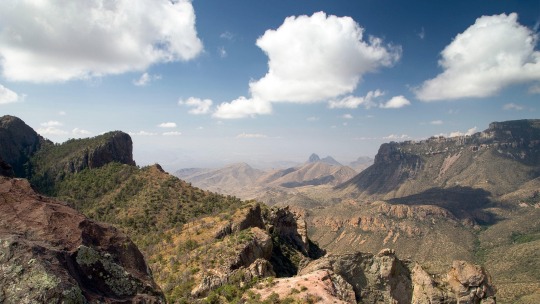
Big Bend National Park! In western Texas along the Mexican border, Big Bend National Park is the largest protected area of Chihuahuan Desert in the U.S. The park consists of vibrant desert habitat, including mountain woodlands and rivers, and supports hundreds of bird species. After the annual spring bloom, birds become scarce during June and July’s hot, dry period; a second flowering and nesting cycle follows, in August and September, during the summer rainy season.
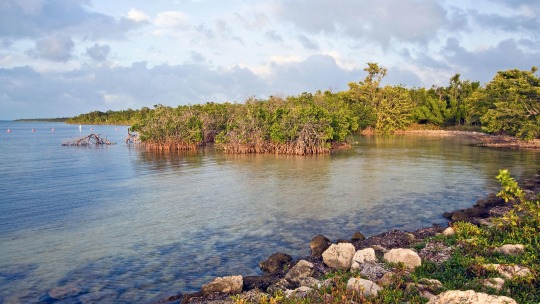
Biscayne National Park! Located in southern Florida, Biscayne National Park is 95 percent water and is home to numerous bird species, including loons, warblers, grebes, wading birds, and pelicans. Part of the Greater Everglades Ecosystem, the park suffers from inadequate freshwater flows, increased salinities, and an ever-growing Miami encroaching on its banks. Along with advancing Everglades restoration components specific to Biscayne Bay, managers can help bird species adapt to a changing climate by working with cooperating agencies and landowners to improve habitat connectivity and buffer zones across boundaries
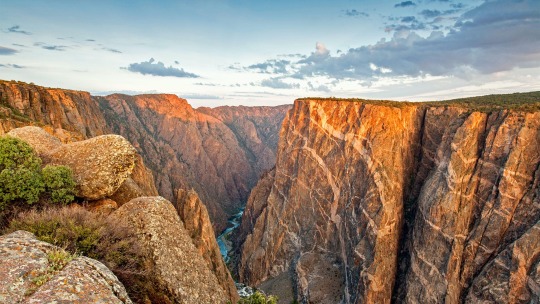
Black Canyon of the Gunnison National Park! Black Canyon of the Gunnison National Park, located in western Colorado, is marked by wetlands, large rock formations, and deep canyons, such as the Black Canyon, which formed 1.5 billion years ago. Birds live in various habitats lining the canyon—from pygmy forests and oak flats at the rim, to shrubs and wildflowers along the canyon walls, to lush cottonwoods growing around the river at the bottom.

Bryce Canyon National Park! Located in southwestern Utah, Bryce Canyon National Park’s vast, arid landscape supports a diverse range of trees, shrubs, and plants, which support birds and other wildlife. By 2050, the park’s climate may become unsuitable for 19 species in summer, including songbirds like the Ruby-crowned Kinglet, Yellow Warbler, and Song Sparrow. In winter, it may be colonized by 43 species not found there today, including those from drier regions like the Crissal Thrasher and Cactus Wren. Due to its arid climate, water conservation and preservation of riparian habitats will be central for management of park resources.
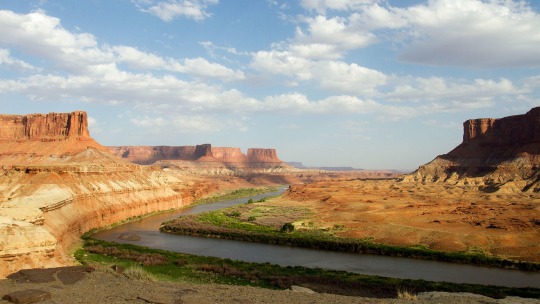
Canyonlands National Park! A recognized Important Bird Area, Canyonlands National Park encompasses the intersection of the Colorado River and the Green River in Utah. In summer, the park’s climate could grow suitable for 19 new bird species like Yellow-crowned Night Herons, Greater Roadrunners, and Painted Buntings by 2050. Unfortunately, park visitors seeking to catch a glimpse of the Gray-crowned Rosy Finch may miss their chance as the climate warms. It is recommended that managers support habitat along the rivers, as this is a refuge for many birds as they migrate across the surrounding desert.
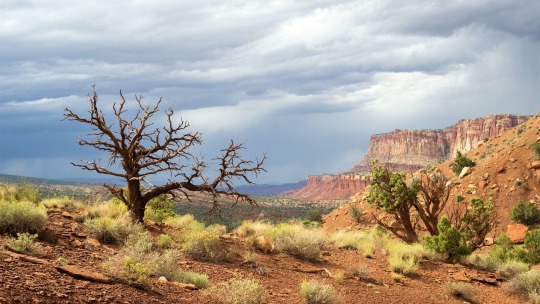
Capitol Reef National Park! At Capitol Reef National Park in south-central Utah, willow thickets and cottonwood forests are juxtaposed against tall canyon walls and expanses of barren red rock. By 2050, this park’s winter climate might become suitable for 57 bird species like the Vermilion Flycatcher, Western Bluebird, and Violet-green Swallow, some of which could begin overwintering in the park. The same climatic changes might cause the extirpation of 20 species in summer, including the American Goldfinch and Tree Swallow. Within Capitol Reef, the Fremont River is an Important Bird Area and a lush oasis in an otherwise arid landscape. It is recommended that managers focus on this area for conservation efforts.
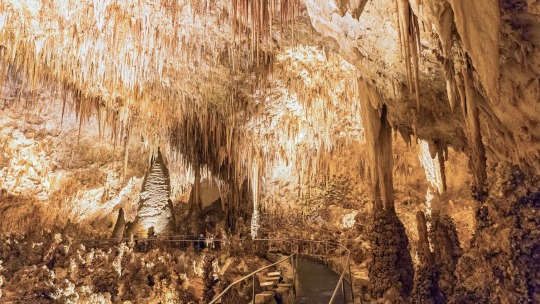
Carlsbad Caverns National Park! New Mexico's Carlsbad Caverns National Park is situated in the Northern Chihuahuan Desert, one of the three most biologically rich and diverse desert ecoregions in the world. Habitats within the park range from lower-elevation desert shrublands and semi-grasslands to higher elevation montane grasslands, shrublands, and woodlands. Riparian woodlands and wetlands are few, but provide critical breeding and stopover habitat for water-loving birds—including Rattlesnake Springs, a designated Important Bird Area. The park is home to 15 species that are highly sensitive to warming temperatures, like the Burrowing Owl. The park will serve as an important refuge for these climate-sensitive species.
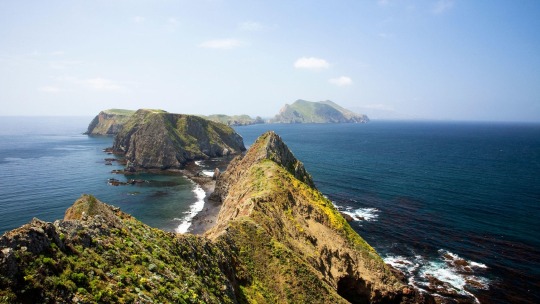
Channel Island National Park! Channel Islands National Park includes five remarkable islands off the coast of southern California, where thousands of years of isolation have created unique habitats and bird populations. This Important Bird Area is home to the only breeding ground for Brown Pelican in California, and they're likely to continue finding suitable climate in the park through 2050. Overall, the park’s climate is projected to become suitable for 26 new species in summer and 27 species in winter, which could potentially colonize the islands. It is recommended that managers continue to optimize habitat for its birds, focusing on maintaining appropriate habitat and working with other agencies to ensure that marine food resources are plentiful.
5 notes
·
View notes
Text
My actual dream job is having a city pay me to go around and properly prune all their fucked up trees and clean up the parks and walking trails, and also talk to everyone who has property along a waterway about the importance of establishing a riparian buffer zone to prevent pollution and erosion
5 notes
·
View notes
Text
Reviving Nature's Flow: Exploring the Essence of Stream Restoration
Stream restoration is an interdisciplinary approach aimed at rehabilitating and revitalizing degraded or altered stream ecosystems to restore their natural functions, improve water quality, and enhance overall ecological health. This process involves a series of planned activities designed to re-establish the natural state of streams that have been affected by human activities, such as urbanization, agriculture, mining, or other land-use changes.
The need for stream restoration arises from the extensive degradation of waterways globally due to human intervention. Degradation can manifest in various forms, including erosion, sedimentation, pollution, altered hydrology, habitat loss, and fragmentation. Stream restoration seeks to address these issues through a combination of techniques tailored to each specific site's needs.
One of the primary goals of stream restoration is to improve the physical structure and geomorphology of streams. This involves reshaping channel morphology, stabilizing banks, and preventing erosion. Natural channel design techniques, such as adding meanders or riffles, and using bioengineering methods with native vegetation, help restore natural flow patterns and stabilize stream banks, thereby reducing erosion and sedimentation.
Restoration efforts also focus on enhancing water quality. Stream restoration projects often involve implementing best management practices (BMPs) to minimize pollutants entering waterways. These practices may include installing vegetated buffers, creating wetlands or riparian zones, and controlling stormwater runoff, which helps filter pollutants and improve water quality.
Another crucial aspect of stream restoration is the restoration of habitats. By reintroducing or enhancing diverse habitat structures within streams, such as riffles, pools, and riffle-pool sequences, restoration efforts aim to provide suitable environments for various aquatic organisms. This supports biodiversity, promotes healthy fish populations, and encourages the recovery of aquatic ecosystems.
Restoration projects also consider reconnecting fragmented streams to promote natural flow regimes and facilitate the movement of organisms. Removing barriers, such as dams or culverts, and restoring connectivity within watersheds are vital to allow fish migration and genetic exchange, contributing to the overall health of aquatic ecosystems.
Community engagement and education are integral components of successful stream restoration initiatives. Involving local communities, stakeholders, and volunteers fosters a sense of ownership and stewardship toward restored streams. Educational programs raise awareness about the importance of healthy streams, promoting sustainable practices and encouraging ongoing support for restoration efforts.
Monitoring and adaptive management are crucial in evaluating the success of stream restoration projects. Regular assessments of ecological indicators, such as water quality parameters, aquatic species diversity, and habitat conditions, help measure the effectiveness of restoration actions. This ongoing monitoring allows for adjustments in management strategies, ensuring the long-term success and sustainability of restoration efforts.
Stream restoration is a complex and dynamic process that requires collaboration among hydrologists, ecologists, engineers, and community members. Successful restoration projects incorporate a holistic approach, integrating science, technology, and community engagement to restore and maintain the ecological integrity of streams, ultimately benefiting both the environment and human communities reliant on healthy aquatic ecosystems.
Cambrilea weed spraying services in NZ, contribute to stream restoration efforts by responsibly managing invasive weeds along streambanks. Targeted weed control, especially of invasive species, can aid in preserving native vegetation, preventing erosion, and improving water quality, indirectly supporting the ecological health of streams. Cambrilea's expertise in weed management plays a role in mitigating the impact of invasive plants on stream ecosystems, contributing positively to restoration initiatives in the region.
0 notes
Text
SoCot to regulate quarry ops in Allah River
#PHnews: SoCot to regulate quarry ops in Allah River
GENERAL SANTOS CITY – The provincial government of South Cotabato is working on stricter regulatory measures for quarrying operations along the critical Allah River, the province’s biggest natural waterway. Agnes Castañares, acting head of the mines and geosciences division of the Provincial Environment Management Office, said Friday they are coordinating with various agencies and stakeholders to properly control and manage the existing sand and gravel quarrying activities in the area. Castañares said they will strictly impose the observance of the one-kilometer buffer zone for the installation of quarry-related structures in the river’s upstream and downstream areas and its tributaries. This will complement the local government’s continuing crackdown against illegal quarry operations in the Allah River, especially in the province’s upper valley area. “This is to protect (the river) and align its flow,” Castañares said in a report. She said they have been coordinating with the quarry operators and concerned local government units regarding the matter, which will be implemented later on in other quarry areas in the province. The 130-kilometer Allah River, which is part of the Allah Valley Protected Landscape, traverses portions of the municipalities of Surallah, Tboli, Lake Sebu, Sto. Nino and Norala. The river flows through the municipalities of Isulan, Esperanza, Bagumbayan, Lambayong, and Tacurong City in Sultan Kudarat before draining into the Mindanao River. Castañares said they are targeting to plant around 23,000 hills of bamboos this year along the banks and riparian zone of the river as part of its continuing riparian conservation and re-vegetation program. She said it would be implemented in partnership with local stakeholders, among them the South Cotabato Foundation Inc., Tribal Leaders Development Foundation Inc., Allah Valley quarry operators and the municipal government of Surallah. “The target area will cover a total of 34.15 kilometers of the Allah River’s riparian zone in Surallah town,” she said. The planting sites are situated in Barangays Buenavista, Colonggolo, Moloy, Centrala, Duengas, Tubi-allah, Lamsugod, Naci, Talahik and Dajay. Castañares said the planting materials would be composed of the Afus, Bayog, and Botong varieties. She said the provincial government, the municipal government of Surallah, and the area’s quarry operators would handle the maintenance of the bamboo re-vegetation areas, which will be expanded later to other portions of the river. (PNA)
***
References:
* Philippine News Agency. "SoCot to regulate quarry ops in Allah River." Philippine News Agency. https://www.pna.gov.ph/articles/1129746 (accessed February 05, 2021 at 11:06PM UTC+14).
* Philippine News Agency. "SoCot to regulate quarry ops in Allah River." Archive Today. https://archive.ph/?run=1&url=https://www.pna.gov.ph/articles/1129746 (archived).
0 notes